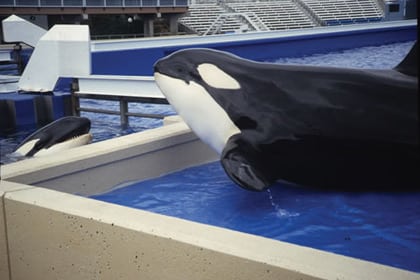How Are They Going To Protect The Animals At Disney World And Dolphins And Whales In Seaworld?
In 1993, Warner Bros released Free Willy, the tale of a captive orca and his 12-twelvemonth-erstwhile human being friend. The popular film concluded with Willy'southward dramatic return to the sea, fifty-fifty if he did have to bound a sea wall to go there. Meanwhile, Keiko, the real-life orca who starred in the picture, was languishing in Reino Aventura, a run-down facility in Mexico, following his capture from the wild in Iceland.
After Free Willy, a powerful public campaign was established to return Keiko to the wild. Through the collaboration of environmental groups, the filmmakers and a private benefactor, Keiko was transferred to a huge sea pen in his native waters in Republic of iceland in 1998. There, Keiko was returned to health, adapted to his new environment and taken out on 'sea walks', where he was equipped with a satellite tag to track his movements as he followed a research boat. In July 2002, after some contact with wild orcas, Keiko began a five-week journeying, alone, across the Atlantic, somewhen arriving in Norway in good health. Although he never joined a wild orca pod, at his decease in Dec 2003, Keiko was a costless whale.
How many orcas are held in capitivity? | Where are orcas held in captivity?
Few captive whales and dolphins accept been returned to the wild after long-term captivity and Keiko may not have been the best candidate, given how fiddling was known virtually where he came from and who his relatives were. In some cases, releases accept been the upshot of dolphins escaping the nets of their littoral enclosures or a storm washing them out to sea. Other efforts take been more deliberate, often following the closure of facilities and weeks or months of dedicated rehabilitation, where individuals relearn important skills for surviving in the wild, such as eating live fish and avoiding boats. Captive bottlenose dolphins have been returned to the wild in Brazil, Guatemala, Nicaragua, Russian federation, the United States, and, most recently, Turkey. 3 dolphins were released in the Turks and Caicos Islands post-obit years of captivity in the UK. In most cases the individuals were seen for months or even years following release.

WDC recommends that the return of any whale or dolphin to the wild should follow strict guidelines. Any release should, where possible, help to conserve wild populations as well asconsider the health and long-term survival of the individual whales and dolphins returned to the wild. They should be released into, or shut to, a population of whales and dolphins they would naturally exist a part of, and into an area which is not heavily polluted. Local dolphin experts should be involved and the whale or dolphin advisedly screened for any disease that might harm wild whales and dolphins. Those released should exist healthy, able to feed themselves on live fish and complimentary of behaviour that could jeopardise their long-term survival, such as approaching boats looking for nutrient. Whale and dolphin releases should be supported as far equally possible by local people, through positive education campaigns. Monitoring of individuals is vital then we know whether the release has been successful.
As public sentiment grows confronting the keeping of highly intelligent, far-ranging creatures in captivity, more individuals are likely to get available for release through the closure of facilities no longer able to proceed them. It'southward possible for whales and dolphins, fifty-fifty those who take lived a long time in captivity, to learn how to hunt over again and survive in the wild. It may even be possible for those built-in in captivity to acquire hunting skills from other whales and dolphins who have lived in the wild, if they are returned in a social grouping.A multi-stage plan should be developed for each individual, with the aim of release, but with long-term intendance options should that non be possible. WDC supports such a plan for Morgan, the wild orca found alone off the Dutch coast in 2010 and now held in very poor conditions at Loro Parque in Tenerife.
Other orcas, including Lolita and Corky, held in captivity in the United States, may be good candidates for release equally researchers know their close family members are live and thriving in the wild. The public supports their return to the wild or retirement in their natural waters but neither marine park property them seems open to supporting such a project. Peradventure they fear that a successful release project would open the floodgates for all captive orcas.
It may non be possible to return all captive whales and dolphins to the wild. Following long spells in captivity, some may be too physically or mentally scarred to survive without human care. These individuals should be offered the chance to retire and live out the residue of their lives in a condom enclosure in a natural cove or bay, where their health and welfare needs are taken care of, they can brandish more natural behaviour, they exercise not accept to perform i shows, and public observation is only from a altitude. WDC is working on an exciting projection with Merlin Entertainments to constitute just such a sanctuary for convict whales and dolphins, the starting time of its kind in the globe.
More on orcas held in captivity
Delight support our piece of work to protect whales and dolphins.
Source: https://us.whales.org/2014/02/26/can-captive-whales-or-dolphins-be-returned-to-the-wild/
Posted by: moodyolded1943.blogspot.com

0 Response to "How Are They Going To Protect The Animals At Disney World And Dolphins And Whales In Seaworld?"
Post a Comment